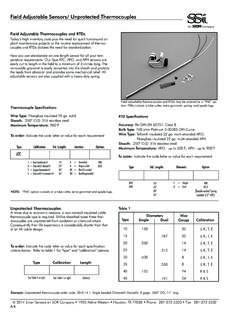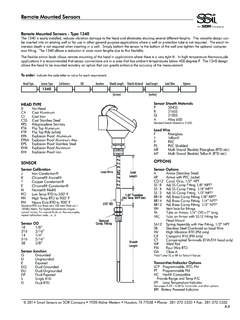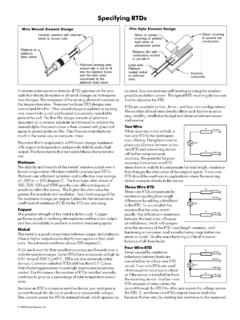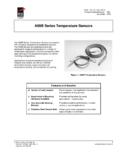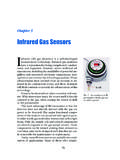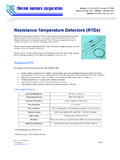Transcription of Thermocouple Specification Criteria - Smart …
1 2003 Smart Sensors, that you know how they work, it s time to get right down tospecifying a Thermocouple . There are a gazzilion parametersyou could consider, however, of the time if you keepthe following in mind your Thermocouple will keep its littlemillivolt heart pumping away forever or until the next mainte-nance shutdown whicheverwhichever occurs Environment: What is the operating tempera-ture that the Thermocouple will be used in? (Select from thetables provided in this section.) What is in the process that willaffect the life or performance of the Thermocouple ?
2 Cost/Performance Ratio: How accurate do I want to be?Do I need Special Limits? How will the dynamics of the processaffect the accuracy? Can I afford the accuracy want?Environment: Do we protect the Thermocouple by installing itin a well? What sheath material do we use on the thermo-couple that will make it compatible with the environment?Calibration: Since the ranges for calibrations tend to overlapthere are other considerations in the selection Criteria . The tablebelow should help. See pages 17-68 for the most commonthermocouple and RTD reference tables or visit our web for all reference Time: Typical response time for thermocouplesrange from a tenth of a second all the way up to 5 seconds,depending on the size of the Thermocouple and the : Typically the larger the OD of the thermocouplethe longer it will last.
3 This Criteria can be tricky. Take the cementcontractor who wanted to measure the temperature of pouredcement. The best Thermocouple for him was a bare wireMeasuring Junction Typical Response TimeSheath ODMeasuring JunctionResponse Time*.063 (1/16 ) (1/8 ) (3/16 ) (1/4 ) *Sensors not in thermowell or protection tubesThermocouple Specification CriteriaCalibrationConductorsTemperature RangeLimits of ErrorExtension WireColor CodingTypePositiveNegative CStandardSpecialJacket ColorJIronConstantan0 C to 750 C C CBlackWhite+(Magnetic)(Non-magnetic)or C to 0 C C-YellowYellow+(Non-magnetic)(Magnetic)o r 2%-Red-0 C to 1250 C C Cor C to 0 C 1 C-BlueBlue+(Non-Magnetic)(Non-magnetic)o r.
4 C to 350 C 1 C Cor C to 0 C C-PurplePurple+(Non-magnetic)(Non-magnet ic)or 1%-Red-0 C to 900 C C 1 Cor C to 1260 C 3/4% 3/8%OrangeOrange+(Non-magnetic)(Non-magn etic)Red-RPlatinumPure Platinum0 C to 1450 C CN/AGreenBlack+13% Rhodium(Non-magnetic)or (Non-magnetic)SPlatinumPure Platinum0 C to 1450 C CN/AGreenBlack+10% Rhodium(Non-magnetic)or (Non-magnetic)BPlatinumPlatinum870 C to 1700 C +30% Rhodium6% RhodiumN/ARed-(Non-magnetic)(Non-magneti c)Calibration Selection GuideCalibration NotesJ- Iron Constantan - Reducing atmosphere recommended.
5 Iron oxidizes rapidly atelevated temperatures. A larger gage size will extend the life of the iron Copper Constantan - Can be used in oxidizing or reducing atmospheres. Rust andcorrosion resistant. Best for sub-zero Chromel Alumel - Oxidizing atmosphere recommended. Most commonly used basemetal Thermocouple . Cycling at high temperatures can cause calibration drift. Notrecommended in sulfur Chromel Constantan - Oxidizing atmosphere recommended. Highest emf output ofthermocouples commonly used. Good corrosion resistanceS, R- Use in oxidizing or inert atmospheres.
6 Not recommended for reducing precipitation from metal protection tubes can cause failure or calibration Use in oxidizing, reducing and inert atmospheres. Not recommended in sulfurenvironments. Improved resistance to drift and better stability over K and E at where the junction was twisted together. He couldcare less what the temperature was or if the Thermocouple wasworking once the cement became concrete. We don t dobusiness with a lot of cement contractors. The data below mayhelp you decide which size Thermocouple is best. Response timeis in seconds and measures a step change in tempera-ture from ambient to boiling is SmartSensors MineralOxide insulatedthermocouplecable with a cutaway of the threemost commonjunctions, (fromleft) ungrounded,exposed, 2003 Smart Sensors, Construction MaterialsThe most basic Thermocouple construction is the wire type consist-ing of two dissimilar metals homogeneously joined at one end toform the measuring junction.
7 All wire-type thermocouples have anexposed junction. While wire-type thermocouples offer goodresponse time, ruggedness, and high temperature use, they aresusceptible to environmental conditions and therefore must insulated thermocouples overcome the disadvantages ofwire type construction by imbedding the Thermocouple wires inceramic insulation and protecting them with a metallic sheath. Themineral insulated cable (MI cable) design is based on small massand high thermal conductivity which in turn promotes rapid heattransfer from the heat source to the measuring sheaths are impervious to most liquids and gases andwithstand high external pressures.
8 The seamless design protectsagainst moisture or other contaminants attacking the thermo-couple elements. Since the only materials used to make the MIcable are the Thermocouple conductors, the mineral oxideinsulation and the metallic sheath, the cables are inherentlyfireproof thus providing the safest temperature measuring Material RecommendedMeltingMax. Fin AirATM *Max. Temp. F304SS25601920 ORNV1650310 SS25601960 ORNV2100316SS22801760 ORNV1650321 SS25801500 ORNV1600347SS26001680 ORNV1600 Inconel Alloy 60025502000 ONV(c)2100 Copper1980600 ORNV (b)600 Aluminum1220800 ORNV700 Platinum32163000ON(c)3050 Molybdenum47501000 VNR4000 Tantalum5440750V4500 Titanium3300600VN2000 Key:O OxidizingR ReducingN NeutralV Vacuum(b) Scales readily in oxidizing atmosphere(c) Sensitive to sulphur corrosionMineral Insulated cable is designed to meet the following specifications:Sheath OD & Wall Thickness: Per ASTME-585 Accuracy.
9 Per ASTME-230 (1993) & ANSI (1988)Sheath MaterialThe table below shows just some of the many different materi-als which can be used to protect the mineral insulated thermo-couple. Sheath materials used vary from standard stainlessalloys like 304, 310, 316, 321, 347, 446 to the slightly moreexotic alloy 600 or Hasteloy .These sheaths are selected based on the rigors of the applica-tion with corrosion and temperature being the leading factorsin sheath selection. The atmospheric environmental parametersare oxidizing, reducing, neutral, and vacuum. For example,304 Stainless Steel can be used in each type of atmospherewith a maximum operating temperature of 1650 Resistance @ Room Temperature: Per ASTME-585 (Table 2)Formability: Per ASTME-585 (Can be formed around a mandrelequal to twice the outside diameter without sheath rupture or lossof IR.)
10 Fabrication: The cable can be welded, brazed or solderedwithout changing IR. (Care should be taken with smaller diametersheaths)See MI Cable Specification Tables on page 9.

